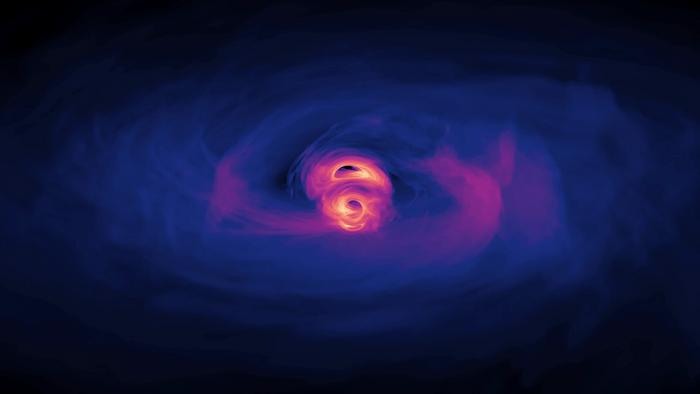Researchers have found a link between some of the largest and smallest objects in the cosmos: supermassive black holes and dark matter particles.

Credit: Credit: NASA’s Goddard Space Flight Center/Scott Noble; simulation data, d’Ascoli et al. 2018
Researchers have found a link between some of the largest and smallest objects in the cosmos: supermassive black holes and dark matter particles.
Their new calculations reveal that pairs of supermassive black holes (SMBHs) can merge into a single larger black hole because of previously overlooked behaviour of dark matter particles, proposing a solution to the longstanding “final parsec problem” in astronomy.
The research is described in Self-interacting dark matter solves the final parsec problem of supermassive black hole mergers published this month in the journal Physical Review Letters.
In 2023, astrophysicists announced the detection of a “hum” of gravitational waves permeating the universe. They hypothesized that this background signal emanated from millions of merging pairs of SMBHs each billions of times more massive than our Sun.
However, theoretical simulations showed that as pairs of these mammoth celestial objects spiral closer together, their approach stalls when they are roughly a parsec apart — a distance of about three light years — thereby preventing a merger.
Not only did this “final parsec problem” conflict with the theory that merging SMBHs were the source of the gravitational wave background, it was also at odds with the theory that SMBHs grow from the merger of less massive black holes.
“We show that including the previously overlooked effect of dark matter can help supermassive black holes overcome this final parsec of separation and coalesce,” says paper co-author Gonzalo Alonso-Álvarez, a postdoctoral fellow in the Department of Physics at the University of Toronto and the Department of Physics and Trottier Space Institute at McGill University. “Our calculations explain how that can occur, in contrast to what was previously thought.”
The paper’s co-authors include Professor James Cline from McGill University and the CERN Theoretical Physics Department in Switzerland and Caitlyn Dewar, a master of science student in physics at McGill.
SMBHs are thought to lie in the centres of most galaxies and when two galaxies collide, the SMBHs fall into orbit around each other. As they revolve around each other, the gravitational pull of nearby stars tugs at them and slows them down. As a result, the SMBHs spiral inward toward a merger.
Previous merger models showed that when the SMBHs approached to within roughly a parsec, they begin to interact with the dark matter cloud or halo in which they are embedded. They indicated that the gravity of the spiraling SMBHs throws dark matter particles clear of the system and the resulting sparsity of dark matter means that energy is not drawn from the pair and their mutual orbits no longer shrink.
While those models dismissed the impact of dark matter on the SMBH’s orbits, the new model from Alonso-Álvarez and his colleagues reveals that dark matter particles interact with each other in such a way that they are not dispersed. The density of the dark matter halo remains high enough that interactions between the particles and the SMBHs continue to degrade the SMBH’s orbits, clearing a path to a merger.
“The possibility that dark matter particles interact with each other is an assumption that we made, an extra ingredient that not all dark matter models contain,” says Alonso-Álvarez. “Our argument is that only models with that ingredient can solve the final parsec problem.”
The background hum generated by these colossal cosmic collisions is made up of gravitational waves of much longer wavelength than those first detected in 2015 by astrophysicists operating the Laser Interferometer Gravitational-Wave Observatory (LIGO). Those gravitational waves were generated by the merger of two black holes, both some 30 times the mass of the Sun.
The background hum has been detected in recent years by scientists operating the Pulsar Timing Array. The array reveals gravitational waves by measuring minute variations in signals from pulsars, rapidly rotating neutron stars that emit strong radio pulses.
“A prediction of our proposal is that the spectrum of gravitational waves observed by pulsar timing arrays should be softened at low frequencies,” says Cline. “The current data already hint at this behavior, and new data may be able to confirm it in the next few years.”
In addition to providing insight into SBMH mergers and the gravitational wave background signal, the new result also provides a window into the nature of dark matter.
“Our work is a new way to help us understand the particle nature of dark matter,” says Alonso-Álvarez. “We found that the evolution of black hole orbits is very sensitive to the microphysics of dark matter and that means we can use observations of supermassive black hole mergers to better understand these particles.”
For example, the researchers found that the interactions between dark matter particles they modeled also explains the shapes of galactic dark matter halos.
“We found that the final parsec problem can only be solved if dark matter particles interact at a rate that can alter the distribution of dark matter on galactic scales,” says Alonso-Álvarez. “This was unexpected since the physical scales at which the processes occur are three or more orders of magnitude apart. That’s exciting.”
-30-
Journal
Physical Review Letters
DOI
10.1103/PhysRevLett.133.021401
Method of Research
Computational simulation/modeling
Subject of Research
Not applicable
Article Title
Self-Interacting Dark Matter Solves the Final Parsec Problem of Supermassive Black Hole Mergers
Article Publication Date
9-Jul-2024
COI Statement
The authors declare no conflict of interest




